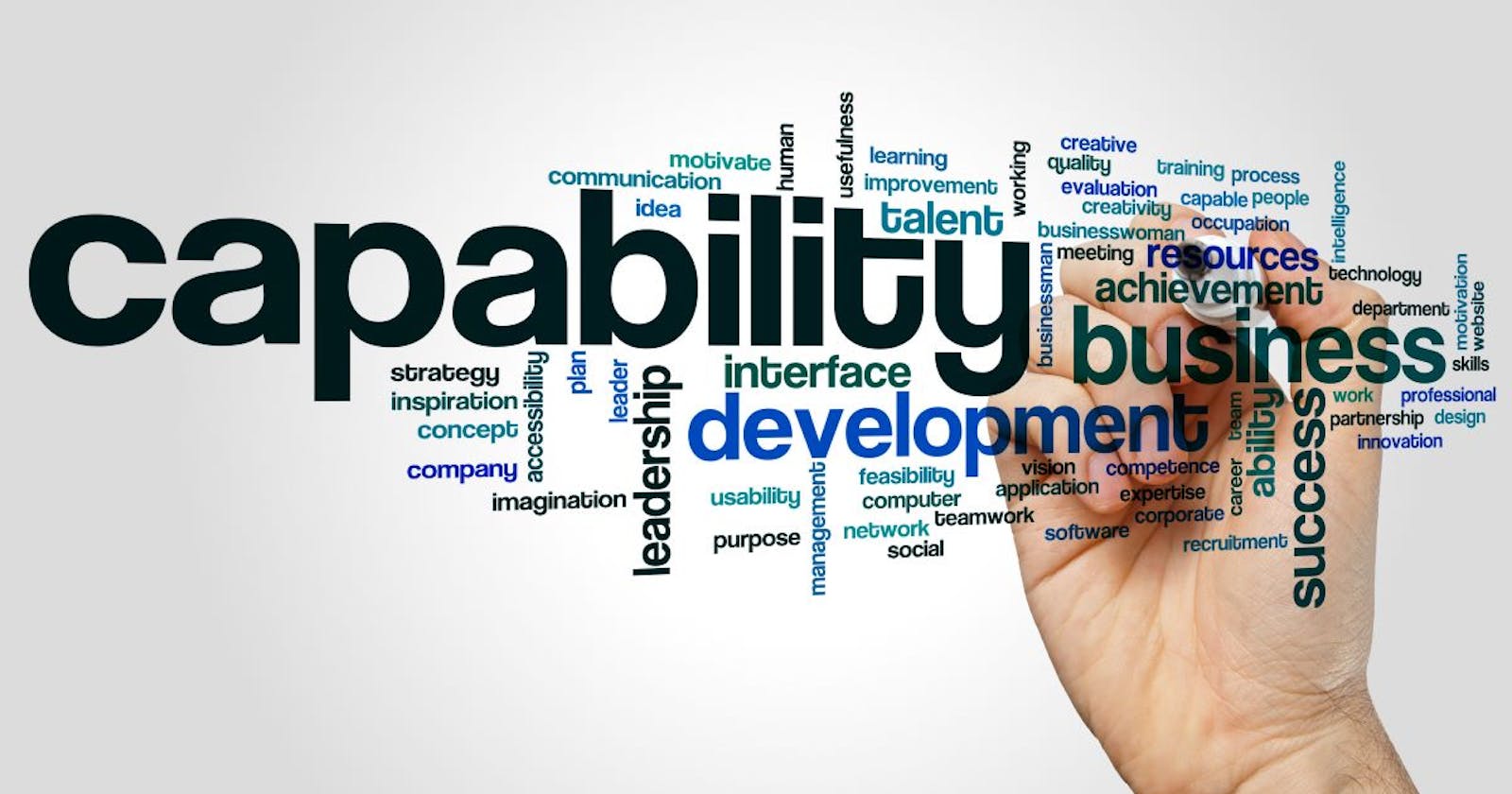Digital Transformations: Don't solve Problems. Build up Capabilities
Transform digitally by developing capabilities for ongoing optimization and innovation, not just problem-solving
The traditional idea management process of generating, evaluating, and selecting ideas to solve specific problems is well-established. Still, it may not be suitable for digital transformation efforts. Digital transformation requires a more comprehensive, strategic approach focused on developing capabilities to achieve business goals rather than solving narrowly defined problems. Organizations establish cross-functional centers of excellence to drive ongoing innovation and adopt new technologies across the enterprise. However, a common pitfall associated with centers of excellence is their tendency to adopt a project-based approach, often leading to creating unique, end-to-end solutions for each initiative. This practice can result in duplicative efforts and complexities, challenging adapting and scaling solutions for future needs. To mitigate these challenges, centers of excellence should pivot towards a more strategic, collaborative approach to identifying and implementing reusable functional capabilities. These capabilities can then be assembled into various solutions as needed. Embracing a modular design and standard building blocks speed up development, enhances adaptability and fosters a culture of continuous digital optimization and innovation. To do so, organizations must determine the critical business and underlying functional capabilities to create their digital platform comprised of reusable building blocks.
Idea Management
It was around 2000 when Idea Management started to gain significant attention. Although it existed before, it was during this time that we began to see many advertisements for Idea Management software solutions, and numerous organizations adopted a more or less sophisticated process. An Idea Management process typically includes the following phases:
Generation - An individual or a group generates an idea and documents it in a structured way.
Evaluation and Selection - Evaluators score and rank ideas based on specific criteria, choosing the most promising ones for further development.
Concept - Developers elaborate on the idea in more detail, identify benefits and potential risks, and conduct an initial technical, financial, and resource feasibility assessment. For some ideas, designers may produce a visual representation or a prototype during this phase.
Business Case - Developers gain a detailed understanding of the idea and confirm its feasibility, quantify the benefits, estimate the costs, and calculate a Return on Investment.
After establishing a compelling Business Case that validates the idea's viability, the final step in the Idea Management process is to obtain the necessary budget and approval from all key stakeholders to kickstart the project.
Numerous organizations have implemented variations of the process described above. The common thread is that the idea development process always revolves around addressing a specific problem.
This approach centers around problem-solving and has proven highly effective for decades. It is a familiar process that has yielded many positive outcomes, from improved meal plans in the cafeteria to innovative software solutions. However, as we pivot towards Digital Transformation, our priorities evolve.
Digital Transformation
In Digital Transformation, our focus shifts away from peripheral concerns like improving cafeteria meal plans to the core issue of how technology influences our business operations and how we can leverage and adapt this technology to create value.
Digital Transformation is a strategic topic, and the good news is that most organizations worldwide have already outlined their digital transformation plans. The first step for these organizations usually involves strategic planning to pinpoint the business capabilities they need to achieve their goals. Next, they define specific actions to develop or improve those capabilities. Regarding Digital Transformation, this often leads to establishing a cross-functional Center of Excellence.
Many organizations have already (successfully) established a team tasked with driving innovation, standardizing processes, and adopting new technologies within the enterprise. Some also promote a digital culture by organizing workshops to share knowledge and encouraging more people to participate in digital transformation efforts.
Once established, a Center of Excellence (CoE) encompasses a broad spectrum of activities, striving not merely for incremental enhancements but for holistic solutions that tackle organizational and technological shifts. As it serves the entire organization, it typically identifies critical areas aligned with business processes and forms cross-functional teams for each, tasked with developing transformative innovations or the "next big thing."
This approach proves highly effective once the Center of Excellence (CoE) solidifies its operational framework. Typically, a CoE's methodology mirrors the Idea Management process, albeit on a grander scale, encompassing the development of robust business cases, securing necessary approvals and budgets, and engaging in implementation efforts. CoEs are adept at crafting compelling business cases to address diverse and specific challenges or occasionally augment existing revenue channels or forge new ones.
Despite the reported success of this strategy in numerous digital transformation initiatives, it raises the question: Does it genuinely foster a culture of continuous digital optimization and innovation?
The Problem of Solving Problems
Let me share my thoughts here. Typically, a business case for a digital solution follows a linear path, such as a single end-to-end process. During the project's planning and execution, all organizational and technical changes are considered with the final solution in mind.
However, this doesn't mean the solution is entirely independent. While architects aim to reuse existing technologies, this approach only sometimes extends to technical adjustments and enhancements at the functional level. Thus, with all its components, the end-to-end process becomes a - on a functional level - unique solution in its own right, even though it's comprehensive.
In subsequent projects, it is common to come across functionalities strikingly similar to previous projects but with a few notable differences. In such cases, the team often tries to repurpose the solutions that worked in the past rather than starting from scratch. However, this approach comes with its own set of challenges. The design of the original solution did not account for adaptability, making its modification for a different project quite tedious, especially if the original project is already operational. This complexity heightens the task's difficulty, and the team might delay or even cancel the implementation of the new project if the cost-benefit analysis does not yield positive outcomes.
Build up Capabilities
I envision and promote establishing a Center of Excellence that focuses on identifying and implementing functional capabilities for the organization. Development teams will then use these capabilities to build concrete projects to maximize reuse and expandability. The aim is to establish a suite of accessible building blocks readily available through a unified platform.
For instance, instead of implementing a satisfaction survey as part of a delivery process, we can create a general ability to design and assess surveys. This way, the delivery process will only be one of many beneficiaries of this capability.
Let's consider Microsoft 365 a platform rather than its individual applications, such as Word, Excel, and OneDrive. The Microsoft 365 platform has many capabilities, including sending and receiving emails, scheduling appointments, sharing documents internally and externally, protecting documents, collaborating on documents, managing tasks, creating and evaluating surveys, and much more.
Of course, the individual capabilities are not a complete solution, but we can reuse the existing basic functionalities, add our specifics, and orchestrate a holistic solution using several of these building blocks. This speeds up solution development considerably, even at the idea generation stage, because it is easier for everyone involved to deduce something new from something existing.
Although Microsoft 365 building blocks differ from your organization's capabilities, you can embed them into your own capabilities. It is essential to determine your business capabilities and derive the functional capabilities to create building blocks for your digitalization platform.
Using a bottom-up capability approach along with a top-down solution approach brings several advantages. It not only accelerates solution development but also separates solutions from specific functions, making them reusable across multiple solutions. This separation also allows for faster modifications.
Functional Capability Example
Let's look at a simple example. Often, when working on a process, we need to inform both internal and external stakeholders. This might be when we reach a certain stage in the process or have a result to share. This could involve sending an email, a Microsoft Teams message, a WhatsApp message, or something similar. We refer to this functional capability as Messaging, which includes the following features and requirements:
Must be able to send messages via Email, Microsoft Teams, WhatsApp, or a combination of these to both individual and multiple recipients.
If a message is sent to an external party, an activity record must be created in our CRM system if the recipient is recorded there. If not, no record is created.
All messages must generate an activity record in our Event Store System, with Personal Identifiable Information being redacted.
For this capability, we've build a generic building block in our platform. It integrates with several existing systems in our technology landscape, such as Microsoft 365 for sending emails and Teams messages, and WhatsApp Business API for messaging. We might also use an external Mail Provider for sending emails to external recipients. Additionally, we integrate with our CRM system to check if an external recipient is listed and to create an activity record. Finally, we have an integration with our log store for general activity logging.
We also add some helpful logic, so that during the solution development phase, messages aren't actually sent but can be viewed through a console.
This is what we publish to our platform, ready to be used by various solutions. We expect this reusable functionality to be utilized multiple times.
Later, a modification is suggested: "If a message is sent to an external party flagged as critical in our CRM system, then the associated account manager must approve the sending before it is actually sent."
We can now update our Messaging capability to meet the new requirement without needing to know where it's used. We might add an approval step right in this building block, but it's more likely we'll pass the actual approval process to an Approval capability.
The Platform
We're nearing the end of this article, but let's briefly discuss the platform itself. What is this platform where you can develop and publish functional capabilities and then combine them into a complete solution? If you're familiar with my other articles, you might guess that I recommend using the OutSystems High-Performance Low-Code Platform as your digital platform. OutSystems is designed with this very concept in mind: a pyramid approach where you build larger solutions from smaller capabilities. However, it's important to note that while OutSystems can be a crucial part of your platform, it shouldn't be the only one. Integrating multiple technologies and other specialized platforms with OutSystems will greatly enhance your efforts.

